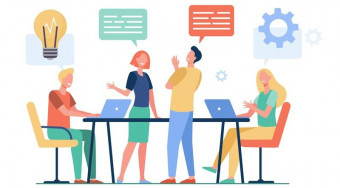Designing Engaging User Experiences
Tags: Product Design
Learn how to apply psychology to design engaging online user experiences that make people take action.
Last updated 2022-01-10 | 4.4
- Use psychology to design more effective- more fun
- and more engaging interactions
- Design with purpose and intent
- Motivate your users to act
What you'll learn
* Requirements
* You should have familiarity with websites* apps
* and/or technology products.
Description
In this 3 hour course, I will go through the most effective persuasive design patterns and explain how you can easily apply them to your own design. You will learn the underlying psychological principles that drive us toward action.
You will learn how to design for engagement
The starting point will be in psychology rather than in graphical design. We will examine how we are as humans: how we think. You will learn what motivate us when we make decisions and how we make decisions. After this course, you will be able to apply this principles to make seductive user experiences, that drive users toward action.
The full life-cycle
The appropriate approach to engaging your users depend on where they are in your product's lifecycle. We will examine all stages of your user-relationship:
- How to get people onboard
- How to get people started and discovering all your product has to offer
- How to make them stick around (and love your product)
An always growing course
I believe in creating the best possible course for you to enjoy. This is why I will continuously be adding more lessons. If you liked the course in its current state then be sure to buy it now, to get free access to all existing and future lessons at the current low rate.
Who this course is for:
- Web designers
- Interaction designers
- Usability professionals
- User Experience professionals
- Entrepreneurs
- Business developers
- Growth hackers
Course content
8 sections • 25 lectures
Welcome Preview 03:46
This course is about how to make seductive interactions - about you can use psychology to design more effective, more fun, and more engaging interactions. With a starting point in psychology rather than in graphical design, you will learn how to design with purpose and intent - how to design for engagement.
From Usability to persuasion Preview 03:42
Traditionally, web design has its focus is on improving usability for the user. Persuasive design has its focus on improving motivation. Rather than focusing on removing friction through usability, the focus of this course is to use increase motivation through psychology.
About the instructor Preview 02:12
Before we start the course, I would like to talk about my background. I have over 20 years of experience, building great websites. First as a web developer. Later managing the interactive division of a Scandinavian media company. Since 2007, I have been running a site called UI-Patterns.com - a site that started an adventure that led to the quest for learning how to build effective and engaging user experiences. This course is an extract version of what I've learned since then.
Aristotle - 3 forms of persuasion Preview 04:41
Aristotle's 3 persuasive appeals: Persuasion of an audience is achieved through communicating credibility, by stirring its emotions, and through arguments suitable to the case in question.
You will learn how to consider multiple aspects of a persuasive argumet.
Building trust Preview 06:08
Lack of trust is often the limiting factor that determines whether a user will perform an action or not. You will learn 10 guidelines on building trust that you can apply to your web design.
Social Proof Preview 02:54
Social proof: We tend to follow the patterns of similar others in new or unfamiliar situations.
Under conditions of uncertainty, we tend to look to others like us to help us decide what to do. You will learn to use this fact to your benefit while still avoiding the magnetic middle.
Authority Preview 04:04
Authority: We want to follow the lead and advice of a legitimate authority
After this lesson, you will have an understanding of how authority can be used effectively to shape the behavior of your users, and know how to specifically play on authority when designing communities and e-commerce solutions. The latter through, expert curation and expert creation.
Reciprocation Preview 05:19
Reciprocation: Obligation to give when you receive. People repay in kind.
The norms of our society ensure social contracts in regards to what we expect of others and what we feel they expect of us is in check. This makes us repay in kind. Revenge is the opposite of reciprocation.
Commitment and consistency Preview 05:09
Commitment and consistency: We desire to act in a manner consistent with our stated beliefs and prior actions.
We want to stay consistant to commitments that are public, active, and voluntary. We will go a long way to avoid a strong dissonance, between our words and our actions. You will learn to effectively use the commitment and consistency principle to help change behavior by finding relevant ways, get small commitments that pave the way for larger commitments, and building momentum.
Liking Preview 05:52
Liking: We prefer to say yes to the requests of someone we know and like.
You will learn how to encourage liking in your communication alone and get an insight into the 3 main drivers of liking.
Cognitive Dissonance Preview 06:40
Cognitive dissonance: When we do something that is not in line with our beliefs, we change our beliefs
You will learn about the counterintuitive fact that our actions influence subsequent beliefs and attitudes and how to apply this to your user experience through several different approaches.
Anchoring Preview 16:26
Anchoring: When making decisions, we rely too heavily, or anchor, on one trait or piece of information.
Nothing is cheap or expensive by itself, but is, compared to something. Learn how to set an anchor in order to establish a more favorable comparisons. You will learn about:
- Partitioned pricing
- Offer payments in increments
- Show the daily equivalence
- Initiate negotiations with a high precise number
- Expose people to a higher “incidental” price
- Or any high number, really
- You can raise the price of your previous product when introducing a new one
- and you can offer a decoy product.
Sources:
- http://ui-patterns.com/patterns/Anchoring
- http://conversionxl.com/pricing-experiments-you-might-not-know-but-can-learn-from/
- http://venturehacks.com/articles/pricing-experiments
- https://www8.gsb.columbia.edu/sites/decisionsciences/files/files/Divide_and_Prosper.pdf
- http://faculty.haas.berkeley.edu/rjmorgan/ebay.pdf
- https://www.shopify.com/blog/26445508-psychological-pricing-is-your-golden-ticket-to-selling-more
- http://bear.warrington.ufl.edu/weitz/mar7786/Articles/reference%20price%20review.pdf
- http://www.mckinsey.com/insights/marketing_sales/do_you_have_a_long-term_pricing_strategy
Recognition over Recall Preview 04:39
Recognition over recall: It's easier to recognize things we have previously experience than it is to recall them from memory.
People are better at recognizing things they have previously experienced than they are recalling those things from memory. Recognition tasks provide memory cues that facilitate searching through memory.
Serial Positioning Effect Preview 02:06
Serial positioning effect: We have a tendency to recall the first and the last items in a series best, and the middle items the worst.
When recalling items from a list, items at the beginning and the end are better recalled than the items in the middle due to the primacy and recency effects.
Chunking Preview 02:07
Chunking: Information grouped into familiar, manageable units is more easily understood and recalled.
Chunking is the technique of combining many units of information into a limited number of units, or chunks, so that the information is easier to process and remember.
Appropriate challenge Preview 04:10
Use an appropriate challenge to engage users to meeting them. We find challenges exciting - especially the ones that strike a balance between overwhelming and boring.
We get a kick through being in flow: when we are constantly moving toward a higher level of complexity, requiring increasingly more difficult challenges to suit a growing skill level. To keep users in flow we need to give them Appropriate challenges.
Rewards Preview 11:08
Rewards: Use rewards to encourage continuation of wanted behavior
You will learn how to distinguish between extrinsic and intrinsic rewards and how to apply different strategies depending on your selected reward type, the social context. You will learn how to plan your rewards and how to construct your reward schedules to maximize the effect of your rewards.
Loss aversion Preview 07:46
Loss aversion: We are risk aversive in decisions regarding gains and risk seeking in decisions regarding losses.
The basic principles of Loss Aversion and Prospect Theory theorized by Daniel Kahneman and Amos Tversky is explained to help you understand how to frame decisions to play on Loss aversion. Furthermore, you will learn how to split up big decisions into smaller bits to maximize the perceived attractiveness of your product.
Endowment effect Preview 07:30
Endowment effect: We place higher value on objects we own over objects we do not, especially if sentimental value has been placed in them.
Learn how to apply the Endowment effect to your web designs using trials, framing, possession, and time invested.
Status quo bias Preview 06:18
Status Quo Bias: We tend to accept the default option instead of comparing the actual benefit to the actual cost
The more complex a decision gets, the harder it is for us, to rely on heuristic shortcuts made from past decisions, to approximate rational thinking. Instead, we tend to accept default options, instead of comparing the actual benefit to the actual cost.
Learn to use this cognitive bias to influence the decisions of your users and learn to help your users break free when they are stuck in their Status Quo Bias.
Scarcity Preview 07:09
Scarcity: If something is promoted as being scarce, it is perceived as more desirable and of more valuable to us.
Learn how you can use the principle of Scarcity to force users into making a decision faster and how it can help increase the perceived value of a product through limiting durations, access, or quantity.
From being seduced to falling in love Preview 07:54
We must adapt our tools of persuasion for how strong our relationship is with a given user. Learn how to adjust interactions by specifically analyzing the sign up problem, the first-time-use problem, and the ongoing engagement problem. Find out when and how to design for tangient, extrinsic, and intrinsic motivation and when it's better to constrain user behavior.
Onboarding - the art of seduction Preview 06:33
Our biggest hope is to get more active users, so we do our best to seduce them, by promising all sorts of benefits, taking them through feature tours, describing all the things our products can do. And when our users are finally ready to unwrap the present, we show them a sign up wall that forces them to log in. This lesson will present 2 ways, in which we can provide a more engaging first time user experience for our new users.
From falling in love to staying in love Preview 06:53
So users are signing up, they are starting to use your software, but you can't seem to hold on to them for a longer period of time. You are dealing with an ongoing engagement problem.
You can successfully apply persuasive principles to your design, in order to let your users experience how great, your product is, faster. But if your product just isn't great and doesn't provide real value for your users, there is no way you will be able to retain them on the longer term, without using force. Business- and user goals need to match. Otherwise, all you will get is a one-night stand.
Your job is to find the sweet spot in the middle.
Thank you for joining this course Preview 00:36
Hopefully, you will find use of the topics covered and can start creating better interactions, today.
If you liked this course, please remember to leave a review.
Thank you.








 This course includes:
This course includes:
















